Effect of Particle Size on the Aerobic and Anaerobic Digestion Characteristics of Whole Rice Straw
Abstract
:1. Introduction
2. Materials and Methods
2.1. Substrates and Inoculums
2.2. Experimental Design
2.2.1. Aerobic Hydrolysis-Acidogenic Test
2.2.2. Anaerobic Digestion Test
2.2.3. Path Analysis
2.3. Analytical Methods
2.4. Data Processing
2.4.1. Lignocellulosic Degradability
2.4.2. Comparison with Removal after AAD
2.4.3. Methane Production
2.4.4. First Order Kinetics of Biodegradable Substrate
2.4.5. Crystallinity Index
2.4.6. Energy Balance
2.4.7. Statistical Analysis
3. Results
3.1. PSD of Rice Straw
3.2. Influence of Particle Size on the Performance of Aerobic and Anaerobic Digestion Process
3.2.1. pH and VFAs Production
3.2.2. Lignocellulose Degradability and vs. Removal
3.2.3. Crystallinity Index
3.2.4. Methane Yield
3.2.5. Relationships between the Parameters after Aerobic Hydrolysis and BMP
3.2.6. Shifts of Bacterial Community
3.2.7. Energy Balance Assessment
4. Conclusions
- (1)
- The particle size distribution was in a narrower range under smaller sieve sizes. The most distributed particles were 0.25–0.425 mm, 0.425–0.6 mm, 0.6–0.85 mm, and 0.85–2 mm in the 1, 3, 5, 7 mm sieve size group indicating the peak gradually moved backward.
- (2)
- The particle size reduction significantly affected the production rather than the composition of VFAs. VFAs were all composed of acetic acid, propionic acid and butyric acid. The maximum content of the VFAs content of 6225.15 mgL−1 was obtained at particle 1 group, 41.20% higher than the particle 4 group, indicating that smaller screen aperture could shorten the hydrolysis and acidification time, promoted solubilization and increased the yield of VFAs.
- (3)
- The particle size had a significant impact on the degradation of cellulose, hemicellulose. The methane yields were improved as the particle size gradually decreased. The 1 mm sieve size group enhanced the methane yield by approximately 6.26%, 17.53%, and 27.65% in comparison with 3, 5, 7 mm sieve size.
- (4)
- The shorter the aerobic time and the larger the sieve aperture, the microbial flora distribution of the group was similar to that of the inoculum. The most dominant phyla were Firmicutes (61.5%), Proteobacteria (9.3%), Chloroflexi (8.3%), Bacteroidetes (4.1%), Cyanobacteria/Chloroplast (4.6%), Atribacteria (1.1%), Planctomycetes (1.1%), Actinobacteria (2.2%).
- (5)
- Although the highest methane yield was observed at 1 mm sieve size group, the net energy balance decreased because of the improvement in crushing energy consumption. To sum up, 3 mm was the most suitable sieve size for further application.
Author Contributions
Funding
Institutional Review Board Statement
Informed Consent Statement
Data Availability Statement
Acknowledgments
Conflicts of Interest
Abbreviations
| BMP | Biochemical methane potential |
| AAD | Aerobic-anaerobic digestion |
| AD | Anaerobic digestion |
| RS | Rice straw |
| PSD | Particle size distribution |
| VFAs | Volatile fatty acids |
| VS | Volatile solids |
| TS | Total solids |
| TC | Total carbon |
| TN | Total nitrogen |
| OLR | Organic load rate |
| TCD | Thermal conductivity detector |
| STP | Standard temperature and pressure |
| FID | Flame ionization detector |
| PCR | Polymerase chain reaction |
| CrI | Crystallinity index |
References
- Wang, D.; Jiang, Z.; Li, B.; Wang, G.; Jiang, Y. Experiment on sliding friction characteristics between rice straw and baler steel-roll. Trans. CSAE 2017, 33, 44–51. [Google Scholar]
- Mustafa, A.M.; Poulsen, T.G.; Sheng, K. Fungal pretreatment of rice straw with Pleurotus ostreatus and Trichoderma reesei to enhance methane production under solid-state anaerobic digestion. Appl. Energy 2016, 180, 661–671. [Google Scholar] [CrossRef]
- Zhao, R.; Zhang, Z.Y.; Zhang, R.Q.; Li, M.; Lei, Z.F.; Utsumi, M.; Sugiura, N. Methane production from rice straw pretreated by a mixture of acetic–propionic acid. Bioresour. Technol. 2010, 101, 990–994. [Google Scholar] [CrossRef]
- Sun, Y.; Zhang, Z.Z.; Sun, Y.M.; Yang, G.X. One-pot pyrolysis route to FeN-Doped carbon nanosheets with outstanding electrochemical performance as cathode materials for microbial fuel cell. Int. J. Agric. Biol. Eng. 2020, 13, 207–214. [Google Scholar]
- Wang, Z.; Liu, Z.Y.; Noor, R.S.; Cheng, Q.S.; Chu, X.D.; Qu, B.; Zhen, F.; Sun, Y. Furfural wastewater pretreatment of corn stalk for whole slurry anaerobic co-digestion to improve methane production. Sci. Total Environ. 2019, 674, 49–57. [Google Scholar] [CrossRef]
- Luo, L.N.; Gong, W.J.; Qin, L.Y.; Ma, Y.W.; Ju, W.C.; Wang, H.Y. Influence of liquid- and solid-state coupling anaerobic digestion process on methane production of cow manure and rice straw. J. Mater. Cycles Waste Manag. 2018, 20, 1804–1812. [Google Scholar] [CrossRef]
- Ambrose, H.W.; Chin, C.T.-L.; Hong, E.; Philip, L.; Suraishkumar, G.K.; Sen, T.K.; Khiadani, M. Effect of hybrid (microwave-H2O2) feed sludge pretreatment on single and two-stage anaerobic digestion efficiency of real mixed sewage sludge. Process Saf. Environ. Protect. 2020, 136, 194–202. [Google Scholar] [CrossRef]
- Candia-García, C.; Delgadillo-Mirquez, L.; Hernandez, M. Biodegradation of rice straw under anaerobic digestion. Environ. Technol. Innov. 2018, 10, 215–222. [Google Scholar] [CrossRef]
- Girotto, F.; Peng, W.; Rafieenia, R.; Cossu, R. Effect of Aeration Applied During Different Phases of Anaerobic Digestion. Waste Biomass Valorization 2016, 9, 161–174. [Google Scholar] [CrossRef]
- Zhang, B.; Li, W.Z.; Xu, X.; Li, P.F.; Li, N.; Zhang, H.Q.; Sun, Y. Effect of Aerobic Hydrolysis on Anaerobic Fermentation Characteristics of Various Parts of Corn Stover and the Scum Layer. Energies 2019, 12, 381. [Google Scholar] [CrossRef] [Green Version]
- Jang, H.M.; Park, S.K.; Ha, J.H.; Park, J.M. Microbial community structure in a thermophilic aerobic digester used as a sludge pretreatment process for the mesophilic anaerobic digestion and the enhancement of methane production. Bioresour. Technol. 2013, 145, 80–89. [Google Scholar] [CrossRef] [PubMed]
- Hajji, A.; Rhachi, M. The Influence of Particle Size on the Performance of Anaerobic Digestion of Municipal Solid Waste. Energy Procedia 2013, 36, 515–520. [Google Scholar] [CrossRef] [Green Version]
- Sebola, M.; Muzenda, E.; Tesfagiorgis, H. Effect of particle size on anaerobic digestion of different feedstocks. S. Afr. J. Chem. Eng. 2015, 20, 11–26. [Google Scholar]
- Palmowski, L.M.; Müller, J.A. Influence of the size reduction of organic waste on their anaerobic digestion. Water Sci. Technol. 2000, 41, 155–162. [Google Scholar] [CrossRef]
- Zou, S.; Wang, H.; Wang, X.; Zhou, S.; Li, X.; Feng, Y. Application of experimental design techniques in the optimization of the ultrasonic pretreatment time and enhancement of methane production in anaerobic co-digestion. Appl. Energy 2016, 179, 191–202. [Google Scholar] [CrossRef]
- Wang, Z.; Cheng, Q.; Liu, Z.; Qu, J.; Sun, Y. Evaluation of methane production and energy conversion from corn stalk using furfural wastewater pretreatment for whole slurry anaerobic co-digestion. Bioresour. Technol. 2019, 293, 121962. [Google Scholar] [CrossRef]
- ANSI/ASAE S424.1 MAR1992 (R2007). Method of Determining and Expressing Particle Size of Chopped Forage Materials by Screening; American Society of Agricultural and Biological Engineers: St. Joseph, MI, USA, 1992; pp. 663–665. [Google Scholar]
- APHA Association. Standard Methods for the Examination of Water and Wastewater, 17th ed.; American Public Health Association: Washington, DC, USA; American Water Works Association: Denver, CO, USA; Water Pollution Control Federation: Alexandria, VA, USA, 1989. [Google Scholar]
- Strömberg, S.; Nistor, M.; Liu, J. Towards eliminating systematic errors caused by the experimental conditions in Biochemical Methane Potential (BMP) tests. Waste Manag. 2014, 34, 1939–1948. [Google Scholar] [CrossRef]
- Zwietering, M.H.; Jongenburger, I.; Rombouts, F.M.; Riet, K.V. Modeling of bacterial growth curve. Appl. Environ. Microbiol. 1990, 56, 1875–1881. [Google Scholar] [CrossRef] [Green Version]
- Batstone, D.J.; Keller, J.; Angelidaki, I.; Kalyuzhnyi, S.V.; Pavlostathis, S.G.; Rozzi, A.; Sanders, W.T.M.; Siegrist, H.; Vavilinet, V.A. The IWA Anaerobic Digestion Model No 1 (ADM1); IWA Publishing: London, UK, 2002; pp. 65–73. [Google Scholar]
- Kong, L.; Zhao, Z.; He, Z.; Yi, S. Effects of steaming treatment on crystallinity and glass transition temperature of Eucalyptuses grandis × E. urophylla. Results Phys. 2017, 7, 914–919. [Google Scholar] [CrossRef]
- Passos, F.; Ferrer, I. Influence of hydrothermal pretreatment on microalgal biomass anaerobic digestion and bioenergy production. Water Res. 2015, 68, 364–373. [Google Scholar] [CrossRef] [Green Version]
- Yuan, T.; Cheng, Y.; Zhang, Z.; Lei, Z.; Shimizu, K. Comparative study on hydrothermal treatment as pre-and post-treatment of anaerobic digestion of primary sludge: Focus on energy balance, resources transformation and sludge dewaterability. Appl. Energy 2019, 239, 171–180. [Google Scholar] [CrossRef]
- Yao, R.S.; Hu, H.J.; Deng, S.S.; Wang, H.; Zhu, H.X. Structure and saccharification of rice straw pretreated with sulfur trioxide micro-thermal explosion collaborative dilutes alkali. Bioresour. Technol. 2011, 102, 6340–6343. [Google Scholar] [CrossRef]
- Miao, Z.; Grift, T.E.; Hansen, A.C.; Ting, K.C. Energy requirement for comminution of biomass in relation to particle physical properties. Ind. Crop. Prod. 2011, 33, 504–513. [Google Scholar] [CrossRef]
- Mani, S.; Tabil, L.G.; Sokhansanj, S. Grinding performance and physical properties of wheat and barley straws, corn stover and switchgrass. Biomass Bioenergy 2004, 27, 339–352. [Google Scholar] [CrossRef]
- Zhao, G.; Ma, F.; Wei, L.; Chua, H. Using rice straw fermentation liquor to produce bioflocculants during an anaerobic dry fermentation process. Bioresour. Technol. 2012, 113, 83–88. [Google Scholar] [CrossRef]
- Montalvo, S.; Huiliñir, C.; Ojeda, F.; Castillo, A.; Lillo, L.; Guerrero, L. Microaerobic pretreatment of sewage sludge: Effect of air flow rate, pretreatment time and temperature on the aerobic process and methane generation. Int. Biodeterior. Biodegrad. 2016, 110, 1–7. [Google Scholar] [CrossRef]
- Fu, S.F.; Wang, F.; Yuan, X.Z.; Yang, Z.M.; Luo, S.J.; Wang, C.S.; Guo, R.B. The thermophilic (55 °C) microaerobic pretreatment of corn straw for anaerobic digestion. Bioresour. Technol. 2015, 175, 203–208. [Google Scholar] [CrossRef] [PubMed]
- Izumi, K.; Okishio, Y.K.; Nagao, N.; Niwa, C.; Yamamoto, S.; Toda, T. Effects of particle size on anaerobic digestion of food waste. Int. Biodeterior. Biodegrad. 2010, 64, 601–608. [Google Scholar] [CrossRef]
- Motte, J.C.; Escudié, R.; Bernet, N.; Delgenes, J.P.; Steyer, J.P.; Dumas, C. Dynamic effect of total solid content, low substrate/inoculum ratio and particle size on solid-state anaerobic digestion. Bioresour. Technol. 2013, 144, 141–148. [Google Scholar] [CrossRef]
- Xu, S.Y.; Selvam, A.; Wong, J.W.C. Optimization of micro-aeration intensity in acidogenic reactor of a two-phase anaerobic digester treating food waste. Waste Manag. 2014, 34, 363–369. [Google Scholar] [CrossRef]
- Dai, X.H.; Hua, Y.; Dai, L.L.; Cai, C. Particle size reduction of rice straw enhances methane production under anaerobic digestion. Bioresour. Technol. 2019, 293, 122043. [Google Scholar] [CrossRef] [PubMed]
- Bar-Lev, S.S.; Kirk, T.K. Effects of molecular oxygen on lignin degradation by Phanerochaete chrysosporium. Biochem. Biophys. Res. Commun. 1981, 99, 373–378. [Google Scholar] [CrossRef]
- Mshandete, A.; Björnsson, L.; Kivaisi, A.K.; Rubindamayugi, S.T.; Mattiasson, B. Enhancement of anaerobic batch digestion of sisal pulp waste by mesophilic aerobic pre-treatment. Water Res. 2005, 39, 1569–1575. [Google Scholar] [CrossRef] [PubMed]
- Xu, W.Y.; Fu, S.F.; Yang, Z.M.; Lu, J.; Guo, R.B. Improved methane production from corn straw by microaerobic pretreatment with a pure bacteria system. Bioresour. Technol. 2018, 259, 18–23. [Google Scholar] [CrossRef] [PubMed]
- Akobi, C.; Yeo, H.; Hafez, H.; Nakhla, G. Single-stage and two-stage anaerobic digestion of extruded lignocellulosic biomass. Appl. Energy 2016, 184, 548–559. [Google Scholar] [CrossRef]
- Mao, C.; Wang, X.; Xi, J.; Feng, Y.; Ren, G. Linkage of kinetic parameters with process parameters and operational conditions during anaerobic digestion. Energy 2017, 135, 352–360. [Google Scholar] [CrossRef]
- Xiao, X.; Zhang, R.H.; He, Y.F.; Li, Y.Q.; Feng, L.; Chen, C.; Liu, G.Q. Influence of Particle Size and Alkaline Pretreatment on the Anaerobic Digestion of Corn Stover. BioResources 2013, 8, 5850–5860. [Google Scholar] [CrossRef] [Green Version]
- Ariesyady, H.D.; Ito, T.; Okabe, S. Functional bacterial and archaeal community structures of major trophic groups in a full-scale anaerobic sludge digester. Water Res. 2007, 41, 1554–1568. [Google Scholar] [CrossRef]
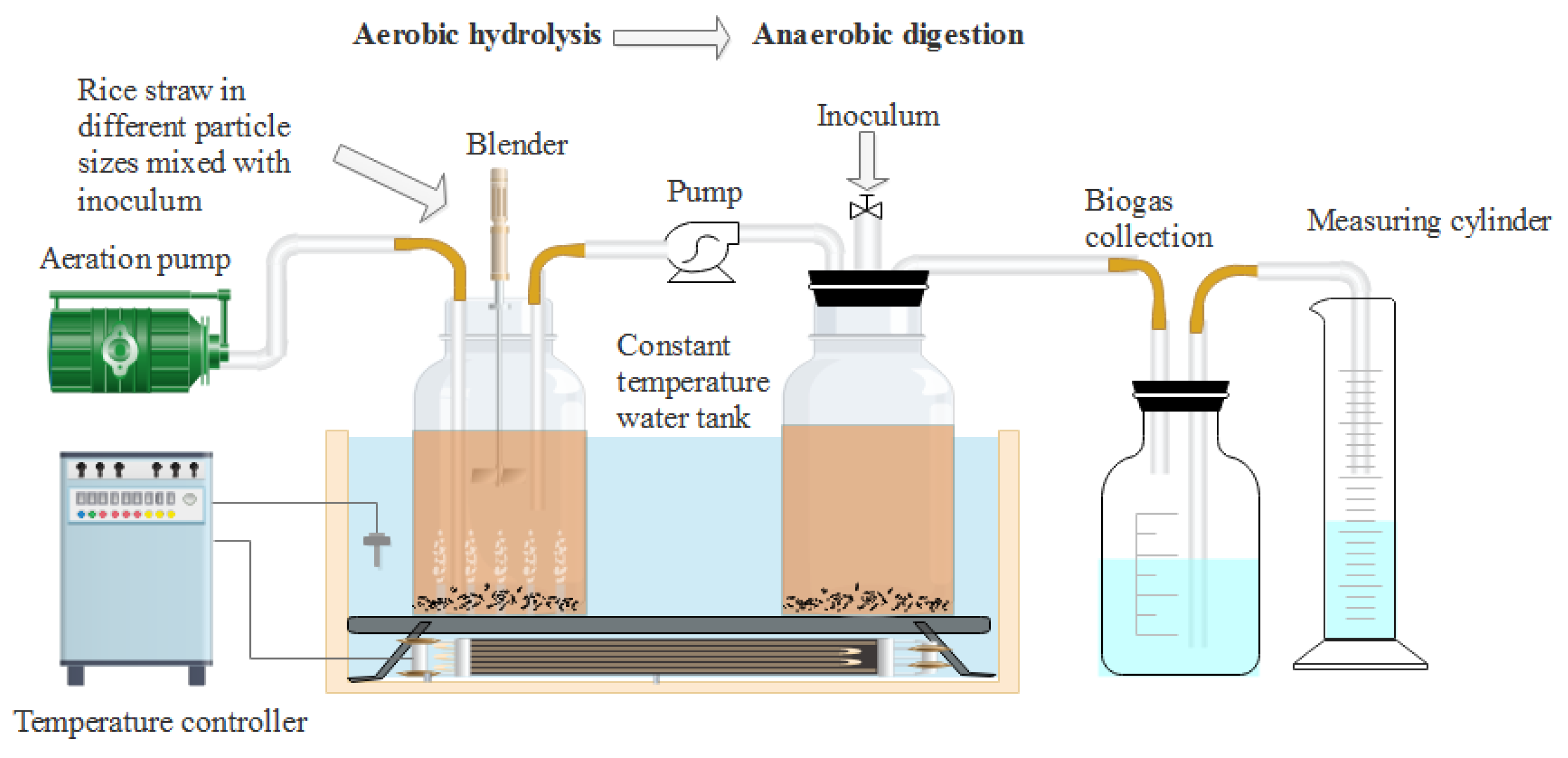
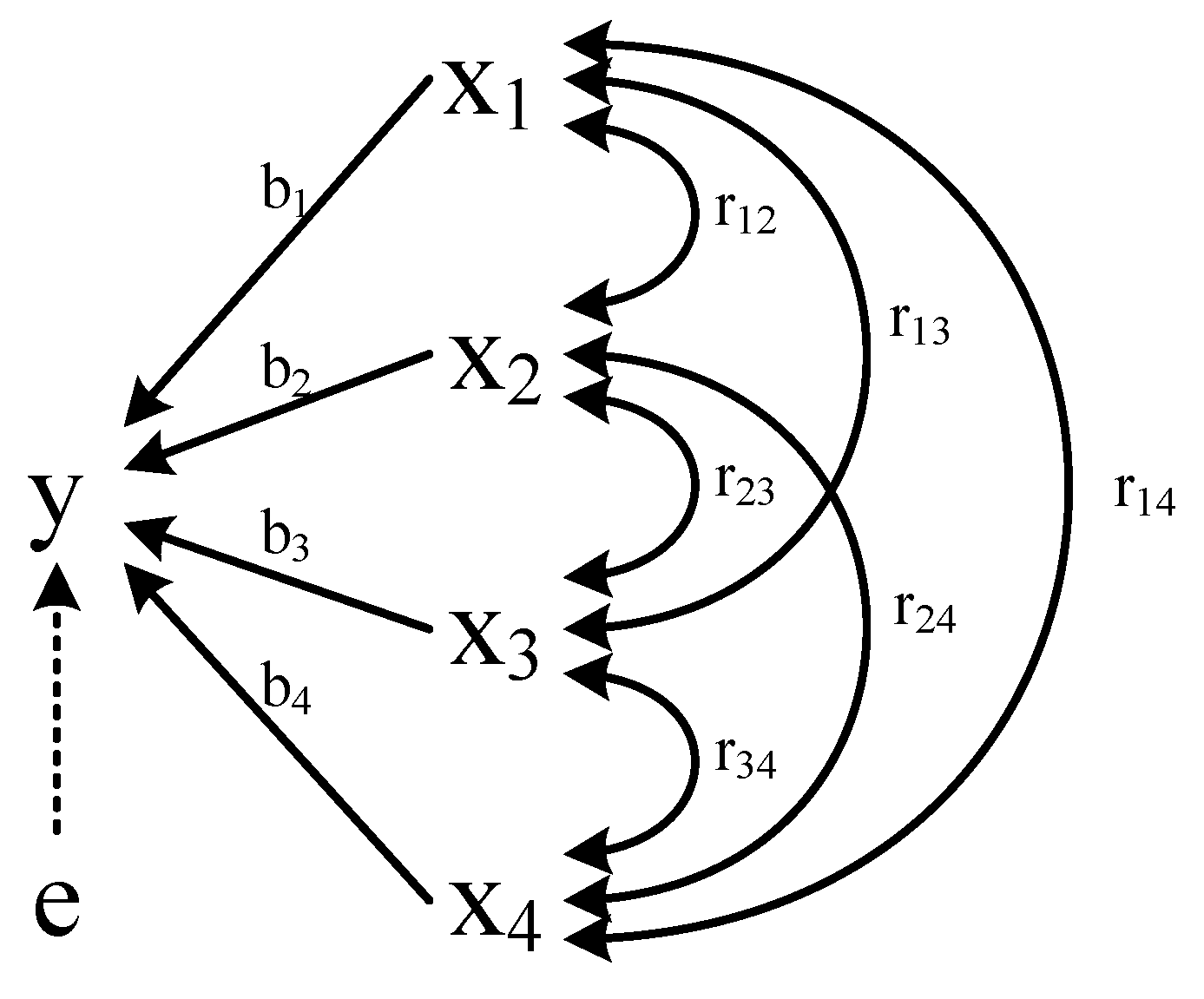


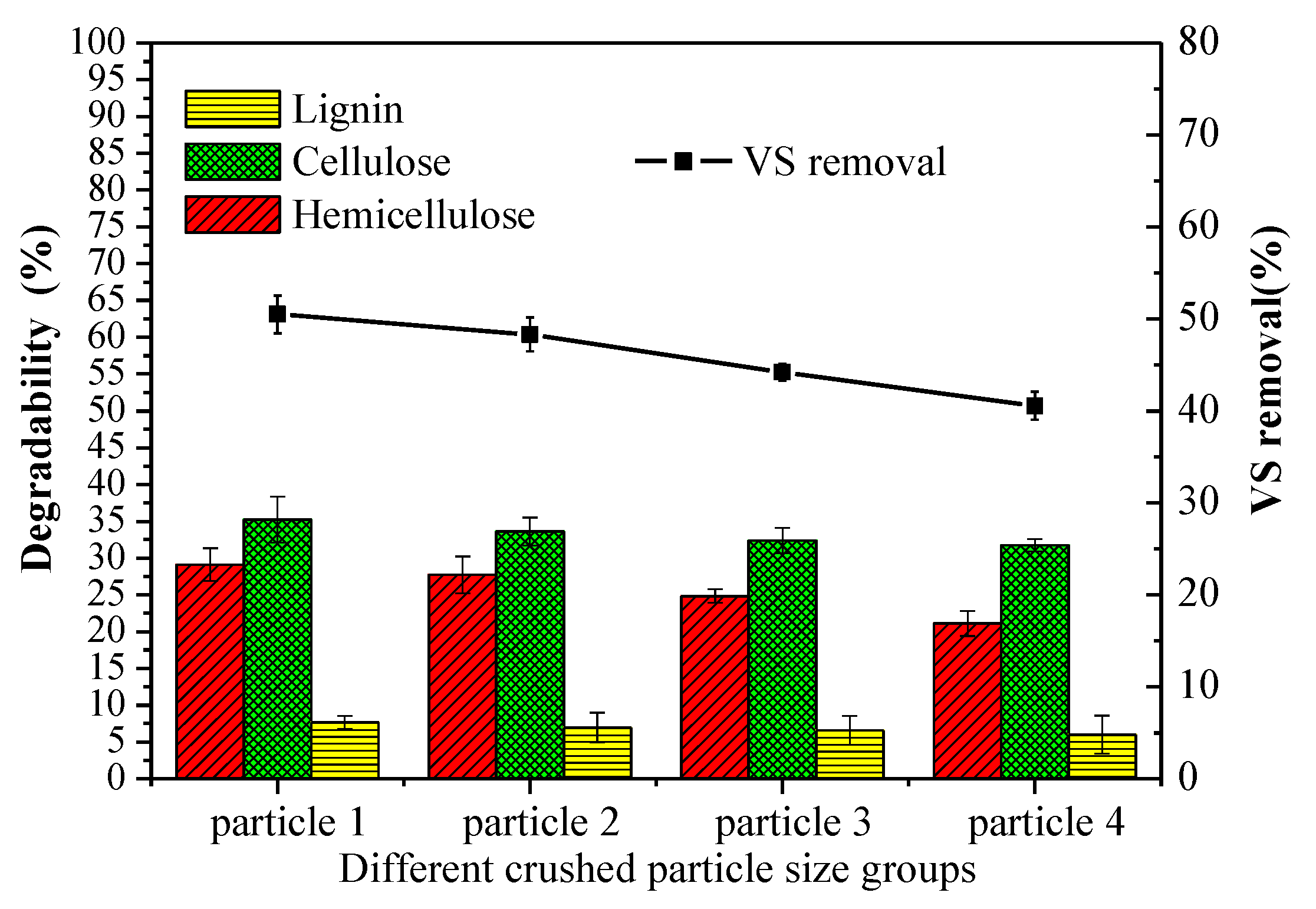
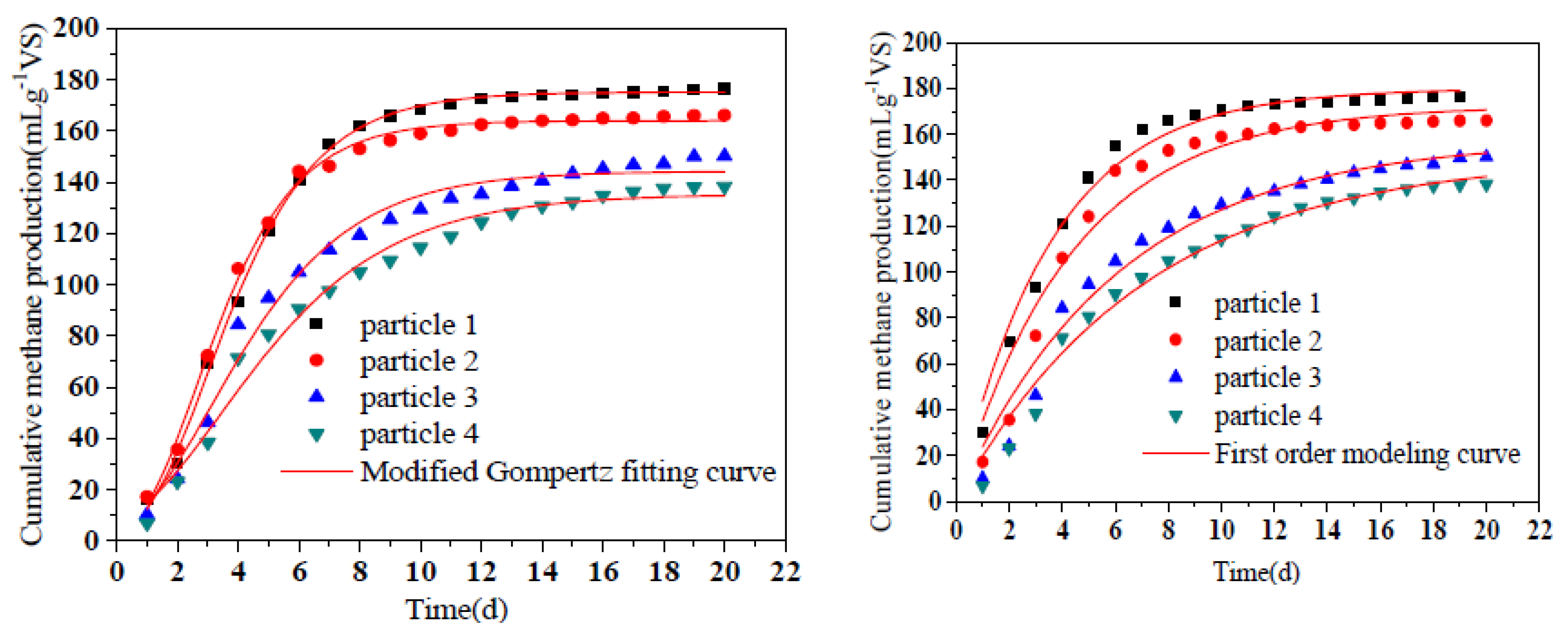
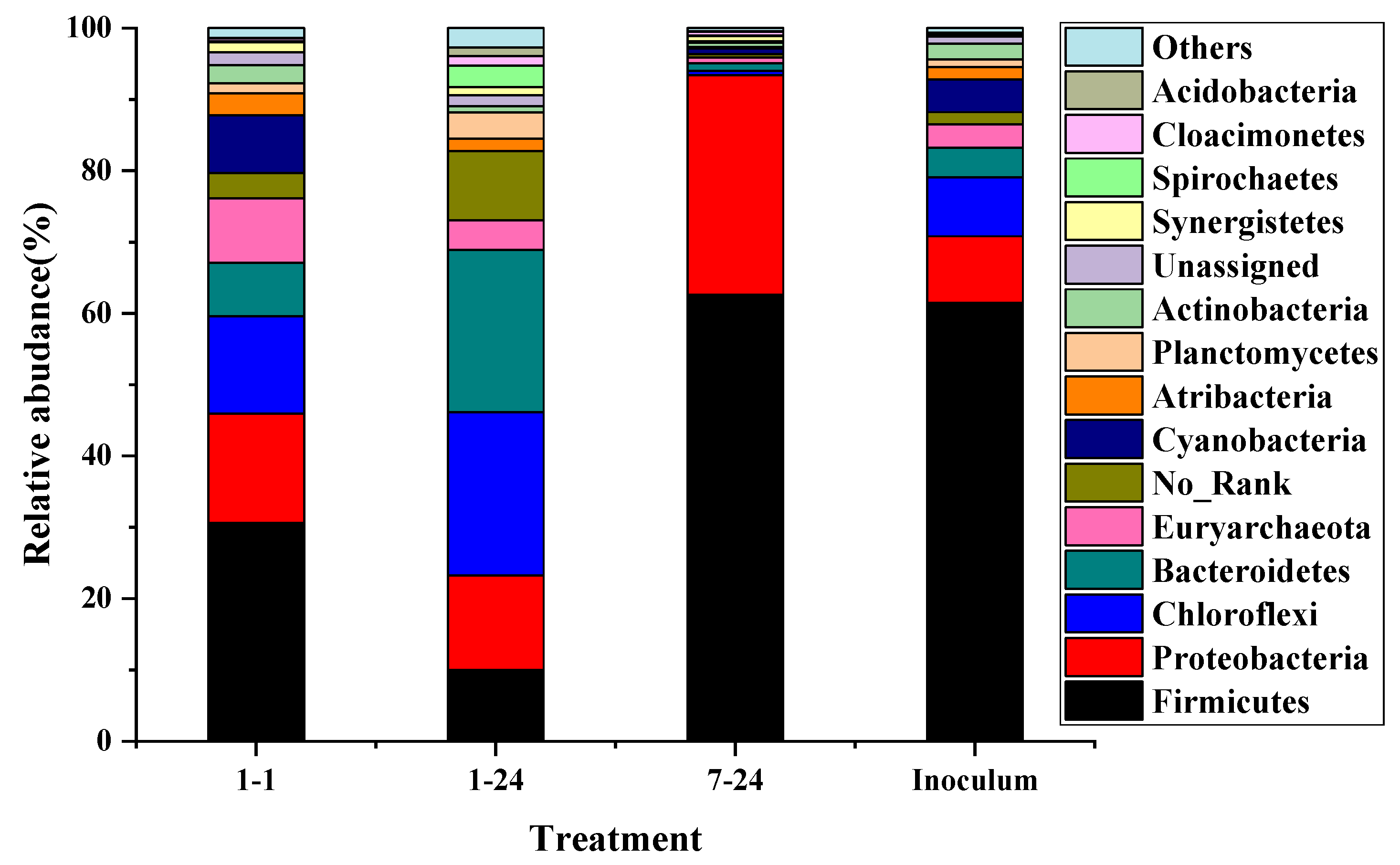
| Parameters | Units | Rice Straw | Aerobic Inoculum | Anaerobic Digestion Sludge |
|---|---|---|---|---|
| Total solids (TS) | (%1) | 90.72 ± 0.10 | 0.55 ± 0.04 | 3.68 ± 0.03 |
| Volatile solids (VS) | (%2) | 80.26 ± 0.03 | 0.28 ± 0.02 | 2.39 ± 0.01 |
| Total Carbon (TC) | (mgL−1) | - | 146.13 ± 1.21 | 269.68 ± 1.49 |
| Total Nitrogen (TN) | (mgL−1) | - | 5.75 ± 0.11 | 8.92 ± 0.39 |
| C | (%2) | 38.86 ± 1.71 | - | - |
| N | (%2) | 1.02 ± 0.03 | - | - |
| Lignin | (%2) | 9.58 ± 0.47 | - | - |
| Cellulose | (%2) | 30.69 ± 0.81 | - | - |
| Hemicellulose | (%2) | 26.35 ± 0.62 | - | - |
| C/N | - | 38.09 ± 0.56 | 25.42 ± 0.28 | 30.27 ± 1.16 |
| pH | - | - | 7.45 ± 0.02 | 7.47 ± 0.03 |
| Treatment | Crystallinity(%) |
|---|---|
| Particle 1 | 15.31 |
| Particle 2 | 15.65 |
| Particle 3 | 16.15 |
| Particle 4 | 21.61 |
| Untreated rice straw | 24.65 |
| Treatment | Modified Gompertz Model | First Order Model | |||||
|---|---|---|---|---|---|---|---|
| P∞ (mLg−1VS) | Rm (mLd−1g−1VS) | λ(d) | R2 | P∞ (mLg−1VS) | k (d−1) | R2 | |
| Particle 1 | 175.13 ± 0.69 a | 31.79 ± 0.75 | 0.94 ± 0.07 | 0.9982 | 179.98 ± 2.24 a | 0.28 ± 0.01 | 0.9810 |
| Particle 2 | 163.94 ± 0.77 b | 33.10 ± 1.03 | 0.80 ± 0.08 | 0.9968 | 172.50 ± 4.34 b | 0.23 ± 0.02 | 0.9495 |
| Particle 3 | 144.24 ± 2.00 c | 20.77 ± 1.45 | 0.58 ± 0.25 | 0.9828 | 157.81 ± 4.68 c | 0.16 ± 0.01 | 0.9675 |
| Particle 4 | 135.31 ± 2.21 d | 16.22 ± 1.11 | 0.37 ± 0.29 | 0.9828 | 150.74 ± 4.62 d | 0.14 ± 0.01 | 0.9768 |
| Factors | ||||||||
|---|---|---|---|---|---|---|---|---|
| ↔x1→y | ↔x2→y | ↔x3→y | ↔x4→y | |||||
| x1 | 0.4616 | 0.833 | 1.315 | 1.1875 | 1.1717 | 1.0296 | −1.0139 | |
| x2 | 0.0475 | 0.893 | 0.027 | 0.0155 | 0.0241 | 0.0134 | −0.0220 | |
| x3 | −0.9937 | 0.372 | −0.692 | −0.5674 | −0.5418 | −0.3446 | 0.3190 | |
| x4 | 0.0681 | −0.763 | −0.046 | 0.1104 | 0.0355 | 0.0374 | 0.0374 | |
| Treatment | Output Energy (kJ/gVSinput) | Input Energy (kJ/gVSinput) | Net Energy Balance (kJ/gVSinput) | |||
|---|---|---|---|---|---|---|
| particle 1 | 5.69 | 0.34 | 0.136 | 0.37 | 0.20 | −0.064 |
| particle 2 | 5.35 | 0.51 | 0.204 | 0.17 | 0.05 | 0.154 |
| particle 3 | 4.84 | 0.39 | 0.156 | 0.12 | 0.03 | 0.126 |
| particle 4 | 4.45 | - | 0.09 | - | - | |
Publisher’s Note: MDPI stays neutral with regard to jurisdictional claims in published maps and institutional affiliations. |
© 2021 by the authors. Licensee MDPI, Basel, Switzerland. This article is an open access article distributed under the terms and conditions of the Creative Commons Attribution (CC BY) license (https://creativecommons.org/licenses/by/4.0/).
Share and Cite
Luo, L.; Qu, Y.; Gong, W.; Qin, L.; Li, W.; Sun, Y. Effect of Particle Size on the Aerobic and Anaerobic Digestion Characteristics of Whole Rice Straw. Energies 2021, 14, 3960. https://doi.org/10.3390/en14133960
Luo L, Qu Y, Gong W, Qin L, Li W, Sun Y. Effect of Particle Size on the Aerobic and Anaerobic Digestion Characteristics of Whole Rice Straw. Energies. 2021; 14(13):3960. https://doi.org/10.3390/en14133960
Chicago/Turabian StyleLuo, Lina, Youpei Qu, Weijia Gong, Liyuan Qin, Wenzhe Li, and Yong Sun. 2021. "Effect of Particle Size on the Aerobic and Anaerobic Digestion Characteristics of Whole Rice Straw" Energies 14, no. 13: 3960. https://doi.org/10.3390/en14133960
APA StyleLuo, L., Qu, Y., Gong, W., Qin, L., Li, W., & Sun, Y. (2021). Effect of Particle Size on the Aerobic and Anaerobic Digestion Characteristics of Whole Rice Straw. Energies, 14(13), 3960. https://doi.org/10.3390/en14133960






